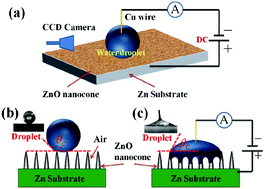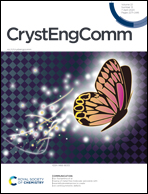Synergistic effects of the tip effect and electric adsorption on the enhanced electrowetting-on-dielectric performance of structured ZnO surfaces
Abstract
To improve the spreading ability of a water droplet on a structured surface, the tip effect is proposed to enhance the local electric field near the cone tip under the application of voltage, and further increases the horizontal force on the water droplet. Thus, a vertical-standing ZnO nanocone array was designed and prepared on a Zn substrate by a simple one-step hydrothermal method, and the cone tip was modulated from a spiculate nanocone to nanorod through adjusting the hydrothermal time and temperature. Experimentally, the electrowetting-on-dielectric (EWOD) responses of the prepared ZnO nanocone array were measured, and the contact angle (CA) modulation under the application of voltage below 30 V reached a value of 89° due to the synergistic effects of the tip effect and electric adsorption. Theoretically, the electric field distribution in the nanocone array was simulated by using the finite element method, and the nanocone array was optimized to enhance the local electric field near the nanocone tip and to suppress the wetting transition from the Cassie state to the Wenzel state. The work is very beneficial to the achievement of a spontaneous switchable EWOD with large CA modulation on the structured surface.



 Please wait while we load your content...
Please wait while we load your content...